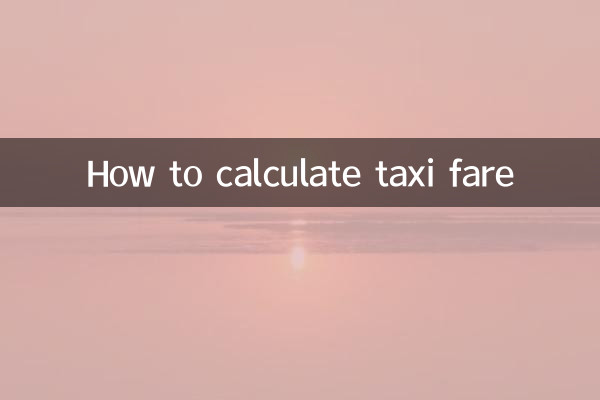How to calculate taxi fare
Recently, taxi fare calculation methods have become one of the hot topics, and many passengers have questions about the fare calculation rules. This article will combine the hot discussions on the entire Internet in the past 10 days, analyze the pricing rules of taxis in detail, and present key information through structured data to help everyone better understand the fee structure.
1. Basic rules for taxi pricing

Taxi fare usually consists of starting price, mileage fee, waiting fee and surcharge. The following is a comparison of taxi pricing standards in major cities across the country:
| city | Starting price (including 3 kilometers) | Mileage fee (yuan/km) | Waiting fee (yuan/minute) | night surcharge |
|---|---|---|---|---|
| Beijing | 13 yuan | 2.3 yuan | 0.5 yuan | 20% |
| Shanghai | 14 yuan | 2.5 yuan | 0.6 yuan | 30% |
| Guangzhou | 12 yuan | 2.6 yuan | 0.4 yuan | 15% |
| Shenzhen | 10 yuan | 2.7 yuan | 0.5 yuan | 25% |
2. Answers to popular questions
1.Why are the charges different for the same distance?
Taxi fares are affected by factors such as road conditions, waiting time, and night surcharges. For example, traffic jams during peak hours will lead to increased waiting fees, and night driving may add 20%-30% to the fee.
2.How to avoid being detoured and overcharged?
It is recommended to use navigation software to check the route in advance and communicate with the driver to confirm. If you find an obvious detour, you can keep your ride voucher and complain to the regulatory authorities.
3.How is the fare calculated when sharing a ride?
The cost of a rideshare is usually split proportionally by the platform, but some cities allow drivers to negotiate with passengers. Here's how common rideshare fares are calculated:
| Number of carpoolers | cost sharing ratio | Example (total cost 50 yuan) |
|---|---|---|
| 2 people | 60%:40% | 30 yuan: 20 yuan |
| 3 people | 50%:30%:20% | 25 yuan: 15 yuan: 10 yuan |
| 4 people | 40%:30%:20%:10% | 20 yuan: 15 yuan: 10 yuan: 5 yuan |
3. Recent hot events
1.New energy taxi pricing adjustment
Many places have issued new pricing regulations for new energy taxis, and some cities have eliminated fuel surcharges, but mileage fees have increased slightly. For example, the mileage fee of new energy taxis in Hangzhou has been adjusted from 2.5 yuan/km to 2.8 yuan/km.
2.Complaints about taxi refusals increase
Recently, passengers in many places have reported that taxi drivers refuse to carry short-distance passengers, and regulatory authorities have stepped up investigations and punishments. Passengers are advised to record their license plate number and call 12328 to complain when they are refused boarding.
3.Controversy over Spring Festival holiday surcharge
Some cities allow service surcharges (5-10 yuan) to be charged during the Spring Festival, but they need to be clearly announced. Passengers may refuse to pay if they encounter unannounced surcharges.
4. Taxi fare calculation example
Suppose you take a taxi in Beijing during the day, travel 10 kilometers (including 3 kilometers for free), and wait in traffic for 10 minutes:
| Expense items | Calculation formula | Amount |
|---|---|---|
| Starting price | Fixed 13 yuan | 13 yuan |
| Mileage fee | (10-3)*2.3 | 16.1 yuan |
| waiting fee | 10*0.5 | 5 yuan |
| total | 13+16.1+5 | 34.1 yuan |
5. Tips for saving money
1. Traveling during off-peak hours can reduce waiting fees;
2. It is more cost-effective to choose carpooling if there are many people traveling together;
3. There are often coupons when using taxi-hailing software;
4. For short-distance travel, consider sharing bicycles or buses.
Through the above analysis, I believe everyone has a clearer understanding of taxi pricing methods. If you have any other questions, you can always consult the local traffic management department for the latest policies.

check the details

check the details